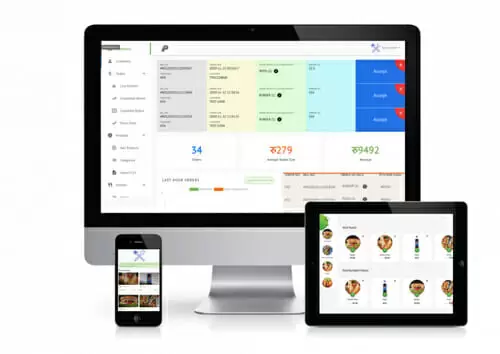Running a retail business, even a small one, involves dealing with many management, executive, and promoting tasks.
A point-of-sale software helps you deal with most of these tasks, enabling you to boost your business to a new level. It enhances sales and gathers the necessary data about the customers.
A POS system simplifies such routine operations as checkout, payments, price control, etc.
Moreover, the customers can see the interface during the transaction. That’s why pos system development is a great idea for the retail industry.
Quick Overlook
How Does a POS System Work?
Let’s start by diving into the specifics of POS systems. Such a system is much smarter than an ordinary cash register.
It is a combination of software and hardware to execute sales, returns, and count the daily income.
Besides this, it has such features as managing inventory, costs, and storehouses and optimizing sales using eCommerce inclusions.
According to statistics, the number of POS users is forecasted to grow up to 1.8 billion by 2025.
Functions of a POS System
A custom-made POS system offers valuable support for retail businesses in all industries.
Before moving on to the custom retail software development, let’s take a closer look at its functionality.
Inventory Management
It enables you to view and account for the items in stock immediately.
A well-developed system can track inventory, reorder low stock items, adjust the tax rates to each product, develop custom prices according to various criteria, and make inventory sales reports.
These are far from all functions of an advanced POS system.
Analyzing and Making Reports
The more data you get, the more success you can reach. Analytics lets you gather and use valuable data.
Monitor your business performance and make wiser and more informed decisions about the future based on the tendencies and collected information.
You can also generate personalized reports according to the requirements of your company.
Employee Management
It helps you handle employees’ work hours and sales efficiency.
All you need is to create user accounts and set the functionality that lets you track each employee’s performance.
You can implement various KPIs to monitor efficiency, such as the price per customer or payments per hour.
Processing Transactions
When you create a pos system for retail, you need to add as many payment methods as possible.
Don’t forget about gift cards and other methods.
The Use of AI and VR
These technologies are revolutionizing the payment market, too.
For instance, a system can take a picture of your face to verify the payment, etc.
If you want to keep up with tendencies, think of interesting features using these technologies.
How to Develop a POS System: Complete Guide
Now that we know the key features of this software let’s move on to making your own pos system.
Implementing a POS system will turn your business into a successful and profitable one.
We recommend turning to the help of software development companies that can tell you exactly what your retail business needs.
If you want to create POS software by yourself, it will take more time and effort.
- First of all, make sure the system corresponds with the latest quality standards. A high-quality POS helps avoid most user questions and issues. A detailed custom system will be able to predict most of them.
- If you want to build a pos system that will satisfy the most users, pay more attention to QA and testing. Ensure your product is perfect even before launch.
- Long-term support is essential for such a solution, so ensure you pick a development company that will never leave your side and continues to provide sufficient backup even after launch.
- Update your products regularly to keep the customers engaged and make the necessary improvements.
- Pay attention to the hardware, as it is a significant element. You can’t simply pick any scanner or printer, and it will work perfectly. As a rule, companies provide ready-made bundles that involve all the necessary equipment.
You also need to pick the POS software type that would be the most beneficial for your business.
Main Types of Custom POS Software
Here are the main types of POS software to choose from.
On-Premise
This is the traditional type that you often see at restaurants and other places. All the data is stored on a local server.
It is convenient to have everything kept in the same place but not so great for performing certain operations.
Other disadvantages are high set-up cost and extra payments for upgrades and support services.
Cloud-Based
This is the safest and most widespread type. In a nutshell, it’s a server for storing data. It is perfect for startups or local companies with many locations. Here are its benefits:
- reasonable cost
- availability from anywhere
- free updates
- High integrability
- Enhanced support
The biggest flaw is the absence of offline mode.
Mobile Systems
This type is cloud-based but designed especially for mobile devices.
It is the most effective, as the number of people who use their mobile phones for making payments is continually growing.
Statistics reveal that the transaction value of mobile POS payments is going to increase to $2.4 million.
Problems You May Face When You Make a POS System
The process is not as easy as it seems. To present an objective picture, we’ll tell you about the most common issues related to implementing POS technology.
Payments are related to sensitive customer data, so ensure you store the history securely.
PCI compliance is a point each business takes into account while picking.
Moreover, you should implement efficient error management and reporting flexibility.
Remember that errors at the point of sale are unacceptable and spoil the overall experience.
To stay competitive, you should offer fair prices. Mind the expenses to launch a system, monthly fees, backup, and transaction fees.
Get acquainted with the offers of other companies and suggest a bit lower pricing.
And probably the most significant thing is scalability. The system should be able to grow with your company, and you should be able to add new features when necessary.
Wrapping Up
We hope our article helped clarify the details of implementing an effective system.
If you are a little confused by the wide range of features, just define what you really need and what can be omitted.


